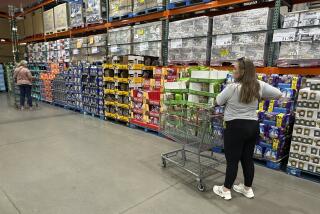More Evidence That Recession Isn’t Near : Reports Show Gains in Industrial Production, Housing Starts
- Share via
WASHINGTON — Industrial production rose for the first time in three months in July while housing starts continued to rebound, the government said Wednesday in reports seen as further evidence that a recession will be avoided this year.
The Federal Reserve said its industrial production index last month stood at 141.7% of its 1977 base, compared to 141.4% in June.
The 0.2% increase in July followed consecutive declines of 0.1% in May and June. Overall production was up 2.7% over a year ago.
In another report, the Commerce Department said housing starts rose 0.8% in July after posting declines for four consecutive months through May. They started to rebound with an 8.5% increase in June.
At the same time, the Fed reported that the factory operating rate remained steady at 83.6% in July, continuing to ease inflationary pressures.
“It’s consistent with the soft-landing scenario, modest growth without tipping into a recession,” Thomas Holloway, senior economist at the Mortgage Bankers Assn. of America, said of the reports.
‘Moderate Strength’
David Berson, chief economist for the Federal National Mortgage Assn., said that several months of stagnant production at manufacturing plants had been causing fears of a recession.
But Wednesday’s report “indicates that manufacturing may have bottomed out and we’re seeing some moderate strength that should help with the soft-landing scenario,” he said.
The Fed has been walking a fine line between keeping interest rates high enough to cool inflationary pressures without slowing growth so much that the economy slides into a recession. It began letting rates drop in June as inflation seemed to lessen.
“The July gain mainly reflected a rebound in the output of total materials as well as continued strength in business equipment excluding motor vehicles,” the central bank said Wednesday in releasing the industrial production report.
“In contrast, automobile and truck production fell sharply, and output of construction supplies, on balance, remained weak,” it said.
Production at manufacturing plants making both durable and non-durable goods rose 0.2% after remaining flat in May and June. That was a 3.3% increase from July, 1988.
Output at mines and oil wells rose 0.3% following a revised 1.1% decline in June caused in part by a coal strike. The July output was 3.5% lower than a year ago.
Production at utilities, reflecting increased use of air conditioning, rose 0.8% in July, following a 1.3% decline in June. Utility production was up 1.2% from July, 1988.
William D. Kelleher, manager of the Community Resources Section of the U.S. Chamber of Commerce, said he was encouraged by the housing report.
“This month’s rebound in housing starts shows that the country’s economic expansion is continuing,” he said.
Natural Falloff
The July level of construction totaled 1.43 million units at a seasonally adjusted annual rate, up from 1.42 million in June.
Single-family construction rose 6.3% last month while apartment starts fell 1.2%. Analysts said the multifamily drop was a natural falloff from an unusually steep 32.9% increase in June.
The operating rate at the nation’s factories remained at 83.6% last month after declining 0.3 percentage point in June, the Fed reported. The rate hit a 10-year high of 84.3% in December. Last month’s operating rate was down from 83.7% a year earlier.
The closer U.S. industry gets to full operating capacity, the greater difficulty it has producing enough to meet demand, leading to shortages and price increases. Analysts generally consider an operating rate of 85% or above as an indication of inflationary pressures.
The operating rate at manufacturing plants slipped 0.1 percentage point to 83.9%, down from June’s 84%. That rate had peaked at 84.7% in January.
The rate at factories producing durable goods--big-ticket items expected to last more than three years--edged down 0.3 percentage point from 82.6% in June. The rate at factories producing non-durable goods rose to 86.2%, compared to 86.1% in June.
More to Read
Inside the business of entertainment
The Wide Shot brings you news, analysis and insights on everything from streaming wars to production — and what it all means for the future.
You may occasionally receive promotional content from the Los Angeles Times.









